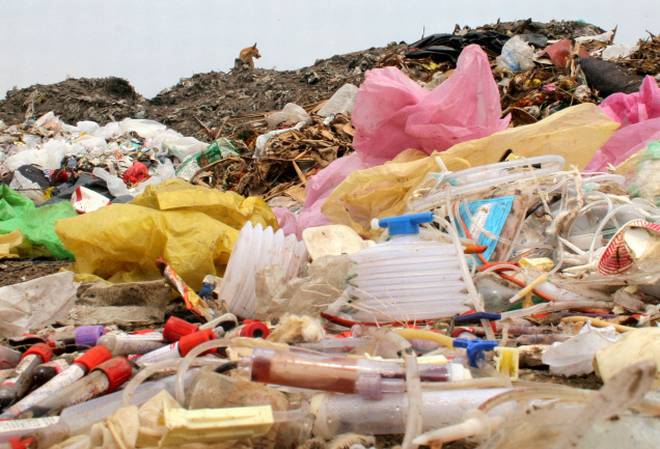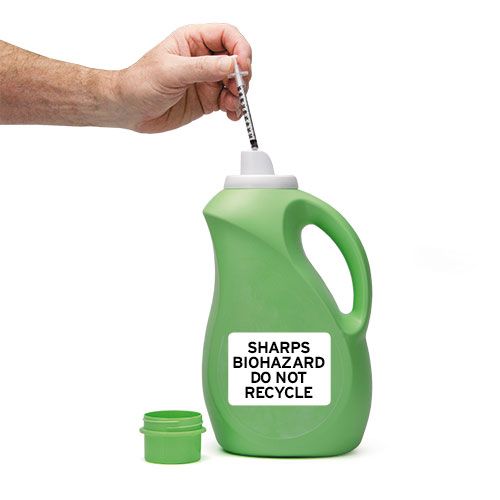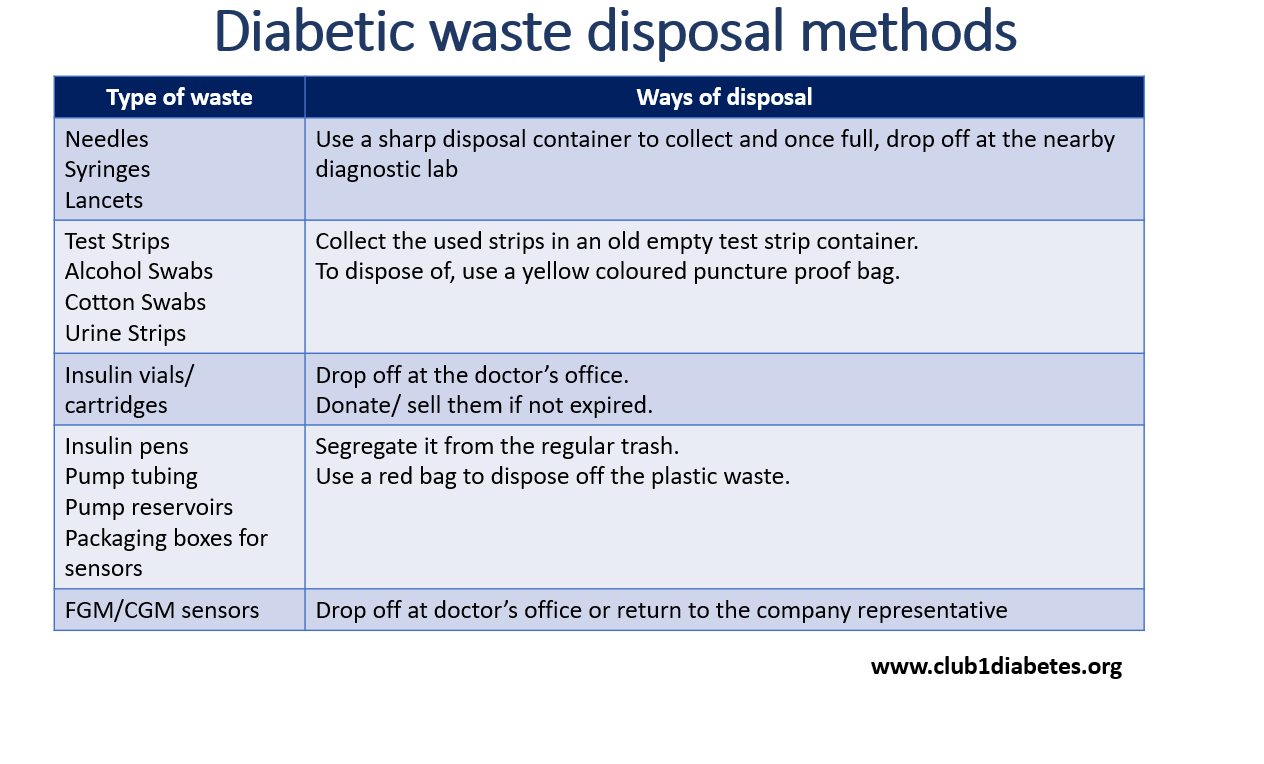Diabetes waste disposal: Are we doing it right?
For the first two weeks after diagnosis, the friendly nurse at the diabetologist’s office administered insulin to me. I am a fully-grown adult and got my mother to check my BG six times a day since I live with trypanophobia. As I prepared to go back to work, I shifted to an insulin pen and learnt to give myself shots and independently check my BG levels. Having successfully overcome my fear of needles, I was thrilled to get back to my old routine while learning the basics of SMBG or diabetes self-care. This meant I had a new set of accessories that became a part of my everyday life. Insulin pens, needles, syringes, cartridges, vials and glucometers.
While this has made life easier, there is a huge amount of diabetic waste that is generated.
On a recent trip abroad, while I combated various known and unknown challenges of being a T1D in a distant land, one of the things which threw me off guard were the stringent rules and laws of sharp waste disposal. I couldn’t dispose off my cartridges or used needles in the trash and had to carry it back home.
During my initial self-monitoring lessons right after diagnosis, effective diabetic waste disposal in home care setting was not taught. I am sure a lot of you reading this will concur the sentiment.
Countries like the US and Canada have stringent rules for bio medical waste and sharp waste disposal in home diabetes care settings.
However I was disappointed to find that there isn’t a single law for home diabetic waste disposal in India.
Here's a quick video on how Ashlesha disposes off her medical waste.
The Bio-medical Waste (Management & Handling) Rules, 1998 are applicable for bio medical waste disposal undertaken by hospitals, nursing homes, clinics, dispensaries, veterinary institutions, pathological laboratories, blood banks, research or educational institutions, medical or surgical camps, vaccination camps, blood donation camps, first aid rooms of schools, etc. In absence of any legal binding on individuals like us who self monitor, are we ready to understand what the implications of incorrect diabetic waste disposal are?
For every action taken, there is an equal and opposite reaction. And this statement holds true in the current scenario. A 2015 report indicates that diabetics in India, both T1D and T2D, consume 160 million insulin syringes, 50 million pen needles, 96 million vials, cartridges and prefills in a 12-month period which adds to the burden of glass and plastic on the environment.
Separate reports and studies indicate an increase in reported cases of blood borne diseases in India due to incorrect bio-medical waste (including sharp waste) disposal. A multi country study among diabetics showed that proportion of various kinds of sharps thrown into the household bin varied from 46.9% to 67.6%. Only in <10% of cases, specific containers were used. Newspaper reports about ragpickers being infected with diseases like HIV, AIDS due to sharps being disposed in regular trash by people including us, type 1 diabetics.

What is diabetic waste?
An insulin dependent diabetic may use one out of syringes, insulin pens or insulin pumps to administer insulin. They would also use glucometers, CGMs or FGMs to monitor BG. Diabetic waste generated may be different for different people depending on what tools they use. However, the waste generated by a diabetic can be broadly categorized as :

Effective diabetic waste disposal methods
The laws and rules for medical waste disposal differ for each country. And unfortunately, India has none in place for home diabetes care. However, that shouldn’t necessarily mean that we as the beneficiaries of this system don’t act responsibly.
So far, I had been disposing off all my diabetic waste in regular trash without any segregation and as I read more about this, I realized the first step towards effective diabetic waste disposal management is to segregate it from regular trash.
In fact, bio medical waste needs to be disposed off in color coded bags to ensure they are correctly treated before final disposal.

There are few steps we can take in disposing off our diabetic waste correctly, as are listed below:
1. Needles/Syringes: These are the sharp wastes and should be carefully disposed of. There are sharp disposal containers available in the market (they are available online too). All the pen needles/ syringes, lancets should be collected in these and once they are full, they can be disposed off.
You can dispose these at any diagnostic lab near you. In case you can’t find a sharp disposal container, you can collect them in a cardboard box (or shampoo bottle like Ashlesha), seal this box, label it and then drop it off at the lab. All labs accept such used sharp waste. They have a proper system for disposing them off as required.

2. Test Strips: Don’t we all have a habit of leaving behind a test strip trail everywhere we go, by strips around? For the longest time, I used to throw the strips as it is in the bin in my room or at work. This increases the risk of blood borne diseases being transferred to the trash handlers/pickers or any person who directly touches these. So now, I always carry an old empty test strip container to collect the used test strips. When I have to discard them, I segregate the test strips from regular trash.

3. Insulin vials/ Cartridges: These add to the glass waste generated. If they are thrown in the trash, the glass could break and hurt someone. To avoid this, you may contact your endocrinologist’s office and hand over any empty/ unused vials and cartridges. In case you wish to dispose them off on your own, please refer to the colour code list above and use it to dispose the vials and cartridges correctly.
4. CGM/FGM sensors: The transmitter and applicator of any CGM / FGM is normally reusable and recyclable. However, sensors can’t be reused. In India, Libre pro is a very popular FGM. Most of the FGM/CGM companies have their own policies put in place to dispose off the sensors. Since the Libre Pro is not a patient version, the sensors can be disposed of at your doctor’s office or given to Abbott representatives for disposal.
5. Glucometers/ Pumps: These are considered as electronic waste. Most of these manufacturing companies offer to take in the old devices when you wish to discard them. Please contact the companies for more information.
You could consider selling / donating your old devices, medicines and test strips as well. In case you do, make sure to double check the expiry dates. Living with diabetes is costly and if you can extend a helping hand, you would be spreading some good in the world.

Let’s take a step forward and do our bit toward Green Diabetology!

SUPPORT BLUE CIRCLE DIABETES FOUNDATION
We need your help and support to continue to grow, expand and touch the lives of countless people in the diabetic community. Every little bit helps us in sustaining this endeavour.
Click here to donate

